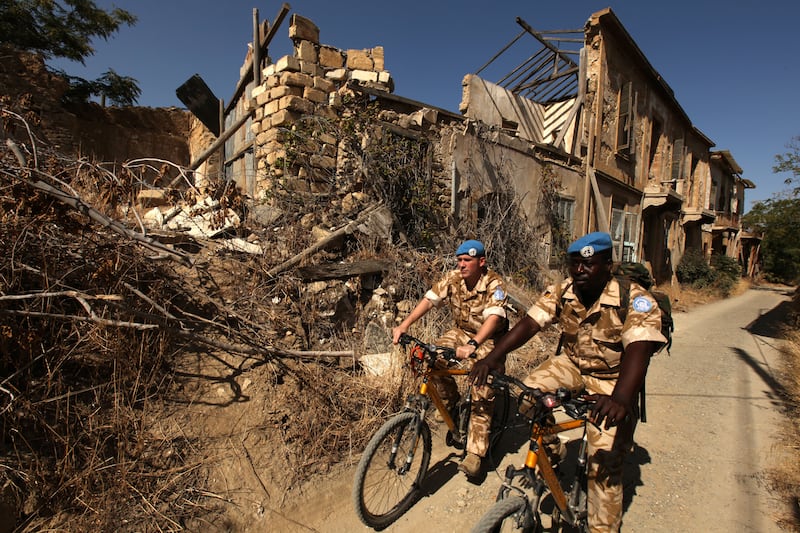Greek and Turkish Cypriots have this week marked the 50th anniversary of the Greek coup which triggered Turkish occupation of the north of the island and its division on July 20th, 1974. At 6am that morning, Turkish warships shelled the northern Kyrenia coast and Turkish paratroopers landed in capital Nicosia.
Memories were jolted when sirens sounded at 8.20am last Monday, marking the start of the coup and reminding Cypriots on both sides of the dividing Green Line of the mainland Greek junta’s attempt on the life of Cypriot president Archbishop Makarios.
That scenario could have been averted. Makarios knew of the plan to kill him and overthrow the independent Cyprus republic. He informed foreign officials, visitors, and journalists – including me in an April interview. He hoped exposure would discourage Athens and alert the US and UK to the risk of war between Greece and Turkey. On July 3rd, Makarios published an open letter to the junta, accusing it of subversion and demanding withdrawal of its officers.
The junta’s goal was Enosis, the political union of Cyprus (which had an 82 per cent Greek-Cypriot majority) with Greece, despite the threat of Turkish intervention to protect the 18 per cent Turkish Cypriots, some of whom called for Taksim, union with Turkey.
RM Block
On July 15th, Makarios was entertaining a group of Egyptian schoolchildren at the presidential palace when rogue Greek-Cypriot fighters and mainland Greek troops attacked. Makarios led the children out a side door, through the garden to the main road, flagged down a car, and escaped to Paphos. That afternoon, pro-junta Greek-Cypriot chauvinist Nicos Sampson was installed as president. US secretary of state Henry Kissinger told Washington’s envoy in Nicosia to receive Sampson’s foreign minister, which was seen as de facto recognition.
Makarios departed on a British military plane for Malta on July 16th, and from there to London the following day. As the former colonial ruler of Cyprus, Britain was – along with Greece and Turkey – a guarantor of Cypriot independence. Makarios appealed to Britain to order troops at its military bases on the island to counter the coup and pre-empt Turkey.
[ Greece set for economic ruin if tourism warnings stay unheededOpens in new window ]
On July 20th, he denounced the coup and invasion at the United Nations Security Council, which called for a ceasefire. Fighting resumed on July 23rd, the day the Athens junta and Sampson fell, and Greece and Cyprus reverted to democratic governance. Nevertheless, Turkey’s invasion continued in stages until August 18th, when Ankara imposed control over the north of Cyprus – 36 per cent of the island. The UN estimated 165,000 Greek Cypriots fled south while 45,000 Turkish Cypriots migrated to the north.
Decades of failed UN-mediated reunification negotiations ensued. The island remained divided, the two communities separated by the Green Line. Talks continued despite the 1983 Turkish-Cypriot declaration of an independent state which was recognised only by Ankara.

In 2003, the Turkish-Cypriots opened crossings between the two sides of the island, ending communal estrangement. Turkish Cypriots came south to work for higher wages and obtained passports from the republic which joined the European Union in 2004. The north was regarded as an area outside government control.
Cyprus is the EU’s sole divided country, Nicosia its only divided capital. In 2019, Ankara instigated the Turkish Cypriots to call for a “two-state solution”, a demand the republic and EU have rejected. UN efforts to restart talks have failed.
While one-third of Greek Cypriots became refugees and lost 78 per cent of the island’s agriculture, manufacturing and tourism capacity in 1974, they recovered, prospered and remain independent. Reliant on Turkey for subsidies and integrated into the Turkish economy, Turkish Cypriots have protested Turkey’s political interference, high inflation and currency devaluation. Dissidents have joined Greek Cypriots calling for reunification, angering Ankara.
- Listen to our Inside Politics Podcast for the latest analysis and chat
- Sign up for push alerts and have the best news, analysis and comment delivered directly to your phone
- Find The Irish Times on WhatsApp and stay up to date















